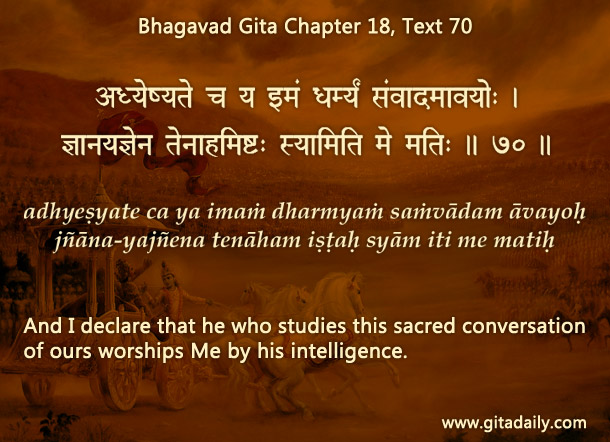
Doctors give patients a didactic explanation centered on what is wrong (diagnosis). But the diagnosis is not the therapy, which involves taking some prescriptions. Thus in normal medical treatment the didactic and therapeutic parts are usually different.
The Bhagavad-gita unites the didactic and the therapeutic in the seamless synthesis of bhakti-yoga. To see how, let’s first understand what the didactic and the therapeutic mean in a spiritual context.
The didactic part involves understanding intellectually the diagnosis. The diagnosis is that we are afflicted with spiritual amnesia, wherein we despite being eternal souls misidentify with the perishable and miserable material body. The therapeutic part involves practicing the process of yoga to stimulate and revive our spiritual consciousness. The Gita (06.47) declares bhakti-yoga to be the highest yoga.
Let’s now see how bhakti-yoga integrates the didactic and the therapeutic. In bhakti-yoga, the therapy involves fixing the mind on Krishna, because he is the supreme spiritual reality.
Significantly, Krishna being omni-potent is non-different from his message – his attractiveness manifests through his words. That’s why when we contemplate the Gita’s didactic message, which gives the diagnosis, we participate in the therapy – we fix the mind on Krishna’s words and thereby on Krishna. The Gita itself (18.70) points to this didactic-therapeutic synthesis: the study of its didactic message is worship of Krishna with the intelligence.
Unfortunately, those who approach the Gita with a hypercritical attitude or an impersonal bias divorce Krishna’s words from him. They see the Gita as an abstract philosophical treatise and Krishna as a literary device or a convenient fiction, thereby rupturing the didactic-therapeutic synthesis.
If we avoid this pitfall and approach the Gita devotionally or at least open-mindedly, then studying it will increase our attraction to Krishna, thereby curing our amnesia and bestowing eternal spiritual happiness.


I have heard that ontologically there is nothing like ignorance; there is only knowledge and absence of knowledge; hence when one gives knowledge to the other, unlike an object, the giver still has the knowledge because he has removed the ignorance of the other person. We see here that there is a similar synthesis of didactic and therapeutic aspects.
Since Bhagavad Gita is a book which removes the ignorance of the reader, if the reader accepts everthing in its entirety, which one will do if one is open minded, it is didactic and therapeutic.
I wonder whether this will be true not only for BG but also for the Vedas, because they are Absolute too?
Yes, it is in principle true for the Vedas too. I have addressed the concept of ignorance here:
http://www.thespiritualscientist.com/?p=19389
ys
ccdas
Hare krishna Prabuji
I must thank you for amazing explanation & also for equally amazing research you have done in Bhagavad Gita verses.
Truly only great realized soul can do this.
Accept my humble obeisances unto you.